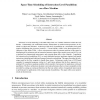Free Online Productivity Tools
i2Speak
i2Symbol
i2OCR
iTex2Img
iWeb2Print
iWeb2Shot
i2Type
iPdf2Split
iPdf2Merge
i2Bopomofo
i2Arabic
i2Style
i2Image
i2PDF
iLatex2Rtf
Sci2ools
105
click to vote
ASPLOS
1998
ACM
1998
ACM
Space-Time Scheduling of Instruction-Level Parallelism on a Raw Machine
Advances in VLSI technology will enable chips with over a billion transistors within the next decade. Unfortunately, the centralized-resource architectures of modern microprocessors are illsuited to exploit such advances. Achieving a high level of parallelism at a reasonable clock speed requires distributing the processor resources – a trend already visible in the dual-register-file architecture of the Alpha 21264. A Raw microprocessor takes an extreme position in this space by distributing all its resources such as instruction streams, register files, memory ports, and ALUs over a pipelined two-dimensional interconnect, and exposing them fully to the compiler. Compilation for instruction-level parallelism (ILP) on such distributed-resource machines requires both spatial instruction scheduling and traditional temporal instruction scheduling. This paper describes the techniques used by the Raw compiler to handle these issues. Preliminary results from a SUIF-based compiler for seque...
ASPLOS 1998 | Instruction Scheduling | Instruction-level Parallelism | Pipelined Two-dimensional Interconnect | Programming Languages |
Related Content
| Added | 05 Aug 2010 |
| Updated | 05 Aug 2010 |
| Type | Conference |
| Year | 1998 |
| Where | ASPLOS |
| Authors | Walter Lee, Rajeev Barua, Matthew Frank, Devabhaktuni Srikrishna, Jonathan Babb, Vivek Sarkar, Saman P. Amarasinghe |
Comments (0)

